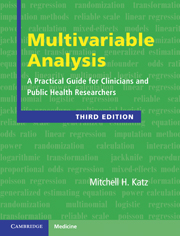Book contents
- Frontmatter
- Contents
- Preface
- 1 Introduction
- 2 Common uses of multivariable models
- 3 Outcome variables in multivariable analysis
- 4 Independent variables in multivariable analysis
- 5 Relationship of independent variables to one another
- 6 Setting up a multivariable analysis
- 7 Performing the analysis
- 8 Interpreting the results
- 9 Delving deeper: Checking the underlying assumptions of the analysis
- 10 Propensity scores
- 11 Correlated observations
- 12 Validation of models
- 13 Special topics
- 14 Publishing your study
- 15 Summary: Steps for constructing a multivariable model
- Index
- References
3 - Outcome variables in multivariable analysis
Published online by Cambridge University Press: 01 April 2011
- Frontmatter
- Contents
- Preface
- 1 Introduction
- 2 Common uses of multivariable models
- 3 Outcome variables in multivariable analysis
- 4 Independent variables in multivariable analysis
- 5 Relationship of independent variables to one another
- 6 Setting up a multivariable analysis
- 7 Performing the analysis
- 8 Interpreting the results
- 9 Delving deeper: Checking the underlying assumptions of the analysis
- 10 Propensity scores
- 11 Correlated observations
- 12 Validation of models
- 13 Special topics
- 14 Publishing your study
- 15 Summary: Steps for constructing a multivariable model
- Index
- References
Summary
How does the nature of the outcome variable influence the choice of which type of multivariable analysis to do?
The choice of multivariable analysis depends primarily on the type of outcome variable that you have (Table 3.1). Therefore, I have organized this chapter by outcome variable: interval (Section 3.2), dichotomous (Section 3.3), ordinal (Section 3.4), nominal (Section 3.5), time to occurrence (Sections 3.6–3.9), count (Section 3.10) and incidence rate (Section 3.11). To help orient you, I have included in Table 3.1 examples of each type of outcome variable, and the statistic generally used to perform a bivariate analysis with the same type of data. My hope is that this will ease your transition from performing bivariate analyses to multivariable analyses.
Although different models are used for different outcome variables, it is sometimes possible to change the nature of the outcome variable (or to test more than one form of your outcome variable). Therefore, in Section 3.12, I discuss ways to transform variables so that they can be analyzed using different multivariable techniques.
Each of the multivariable models has a different set of underlying assumptions. Therefore to help you choose the correct model and interpret the output correctly I have included the underlying assumptions for each of the models within each section. In Chapter 9, I review methods of testing the underlying assumption of the multivariable models.
- Type
- Chapter
- Information
- Multivariable AnalysisA Practical Guide for Clinicians and Public Health Researchers, pp. 25 - 73Publisher: Cambridge University PressPrint publication year: 2011



